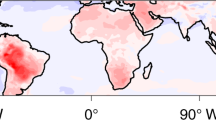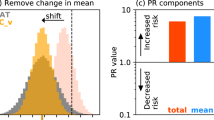Abstract
Precipitation extremes increase in intensity over many regions of the globe in simulations of a warming climate1,2,3. The rate of increase of precipitation extremes in the extratropics is consistent across global climate models, but the rate of increase in the tropics varies widely, depending on the model used3. The behaviour of tropical precipitation can, however, be constrained by observations of interannual variability in the current climate4,5,6. Here I show that, across state-of-the-art climate models, the response of tropical precipitation extremes to interannual climate variability is strongly correlated with their response to longer-term climate change, although these responses are different. I then use satellite observations to estimate the response of tropical precipitation extremes to the interannual variability. Applying this observational constraint to the climate simulations and exploiting the relationship between the simulated responses to interannual variability and climate change, I estimate a sensitivity of the 99.9th percentile of daily tropical precipitation to climate change at 10% per K of surface warming, with a 90% confidence interval of 6–14% K−1. This tropical sensitivity is higher than expectations for the extratropics3 of about 5% K−1. The inferred percentage increase in tropical precipitation extremes is similar when considering only land regions, where the impacts of extreme precipitation can be severe.
This is a preview of subscription content, access via your institution
Access options
Subscribe to this journal
Receive 12 print issues and online access
$259.00 per year
only $21.58 per issue
Buy this article
- Purchase on Springer Link
- Instant access to full article PDF
Prices may be subject to local taxes which are calculated during checkout



Similar content being viewed by others
References
Kharin, V. V., Zwiers, F. W., Zhang, X. & Hegerl, G. C. Changes in temperature and precipitation extremes in the IPCC ensemble of global coupled model simulations. J. Clim. 20, 1419–1444 (2007).
Sun, Y., Solomon, S., Dai, A. & Portmann, R. W. How often will it rain? J. Clim. 20, 4801–4818 (2007).
O’Gorman, P. A. & Schneider, T. The physical basis for increases in precipitation extremes in simulations of 21st-century climate change. Proc. Natl Acad. Sci. USA 106, 14773–14777 (2009).
Allan, R. P. & Soden, B. J. Atmospheric warming and the amplification of precipitation extremes. Science 321, 1481–1484 (2008).
Allan, R. P., Soden, B. J., John, V. O., Ingram, W. & Good, P. Current changes in tropical precipitation. Environ. Res. Lett. 5, 025205 (2010).
Liu, C. & Allan, R. P. Multisatellite observed responses of precipitation and its extremes to interannual climate variability. J. Geophys. Res. 117, D03101 (2012).
Parry, M. L. et al. in IPCC Climate Change 2007: Impacts, Adaptation and Vulnerability (eds Parry, M. L. et al.) 23–78 (Cambridge Univ. Press, 2007).
Pall, P. et al. Anthropogenic greenhouse gas contribution to flood risk in England and Wales in autumn 2000. Nature 470, 382–385 (2011).
Trenberth, K. E., Dai, A., Rasmussen, R. M. & Parsons, D. B. The changing character of precipitation. Bull. Am. Meteorol. Soc. 84, 1205–1217 (2003).
O’Gorman, P. A. & Schneider, T. Scaling of precipitation extremes over a wide range of climates simulated with an idealized GCM. J. Clim. 22, 5676–5685 (2009).
Groisman, P. Y. et al. Trends in intense precipitation in the climate record. J. Clim. 18, 1326–1350 (2005).
Min, S. K., Zhang, X., Zwiers, F. W. & Hegerl, G. C. Human contribution to more-intense precipitation extremes. Nature 470, 378–381 (2011).
Wilcox, E. M. & Donner, L. J. The frequency of extreme rain events in satellite rain-rate estimates and an atmospheric general circulation model. J. Clim. 20, 53–69 (2007).
Muller, C. J., O’Gorman, P. A. & Back, L. E. Intensification of precipitation extremes with warming in a cloud resolving model. J. Clim. 24, 2784–2800 (2011).
Romps, D. M. Response of tropical precipitation to global warming. J. Atmos. Sci. 68, 123–138 (2011).
Sobel, A. H. & Camargo, S. J. Projected future seasonal changes in tropical summer climate. J. Clim. 24, 473–487 (2011).
Lenderink, G. & Van Meijgaard, E. Increase in hourly precipitation extremes beyond expectations from temperature changes. Nature Geosci. 1, 511–514 (2008).
Lu, J., Chen, G. & Frierson, D. M. W. Response of the zonal mean atmospheric circulation to El Niño versus global warming. J. Clim. 21, 5835–5851 (2008).
Chou, C. & Tu, J. Y. Hemispherical asymmetry of tropical precipitation in ECHAM5/MPI-OM during El Niño and under global warming. J. Clim. 21, 1309–1332 (2008).
Hall, A. & Qu, X. Using the current seasonal cycle to constrain snow albedo feedback in future climate change. Geophys. Res. Lett. 33, L03502 (2006).
Knutti, R., Meehl, G. A., Allen, M. R. & Stainforth, D. A. Constraining climate sensitivity from the seasonal cycle in surface temperature. J. Clim. 19, 4224–4233 (2006).
Guilyardi, E. et al. Understanding El Niño in ocean–atmosphere general circulation models. Bull. Am. Meteorol. Soc. 90, 325–340 (2009).
Hilburn, K. A. & Wentz, F. J. Intercalibrated passive microwave rain products from the unified microwave ocean retrieval algorithm (UMORA). J. Appl. Meteorol. 47, 778–794 (2008).
Smith, T. M., Reynolds, R. W., Peterson, T. C. & Lawrimore, J. Improvements to NOAA’s historical merged land–ocean surface temperature analysis (1880–2006). J. Clim. 21, 2283–2296 (2008).
O’Gorman, P. A. & Muller, C. J. How closely do changes in surface and column water vapor follow Clausius–Clapeyron scaling in climate-change simulations? Environ. Res. Lett. 5, 025207 (2010).
Kummerow, C. et al. The evolution of the Goddard Profiling Algorithm (GPROF) for rainfall estimation from passive microwave sensors. J. Appl. Meteorol. 40, 1801–1820 (2001).
Huffman, G. J. et al. Global precipitation at one-degree daily resolution from multisatellite observations. J. Hydrometeorol. 2, 36–50 (2001).
Huffman, G. J. et al. The TRMM multisatellite precipitation analysis (TMPA): Quasi-global, multiyear, combined-sensor precipitation estimates at fine scales. J. Hydrometeorol. 8, 38–55 (2007).
Jones, P. W. First- and second-order conservative remapping schemes for grids in spherical coordinates. Mon. Weath. Rev. 127, 2204–2210 (1999).
Chen, C. T. & Knutson, T. On the verification and comparison of extreme rainfall indices from climate models. J. Clim. 21, 1605–1621 (2008).
Acknowledgements
I am grateful to C. Kummerow, T. Schneider, M. Tingley, R. Allan, K. Emanuel, C. Wunsch, S. Solomon and T. Merlis for helpful discussions. I acknowledge the World Climate Research Programme’s Working Group on Coupled Modelling, which is responsible for CMIP, and I thank the climate modelling groups for producing and making available their model output. For CMIP the US Department of Energy’s Program for Climate Model Diagnosis and Intercomparison provides coordinating support and led development of software infrastructure in partnership with the Global Organization for Earth System Science Portals. SSM/I (V6) data were provided by RSS (www.remss.com) and sponsored by the NASA Earth Science MEaSUREs DISCOVER Project. SSM/I and TMI GPROF (V10) data were downloaded from http://rain.atmos.colostate.edu/. GPCP 1DD (V1.1) data were downloaded from http://www1.ncdc.noaa.gov/pub/data/gpcp/. TRMM 3B42 (V7) daily data were provided by the Goddard Earth Sciences Data and Information Services Center. NOAA Merged Air Land and SST anomalies (V3.5.1) were provided by the NOAA/OAR/ESRL PSD from their website at http://www.esrl.noaa.gov/psd/. I acknowledge support from NSF grant AGS-1148594 and NASA grant NNX-11AO92G.
Author information
Authors and Affiliations
Corresponding author
Ethics declarations
Competing interests
The author declares no competing financial interests.
Supplementary information
Supplementary Information
Supplementary Information (PDF 371 kb)
Rights and permissions
About this article
Cite this article
O’Gorman, P. Sensitivity of tropical precipitation extremes to climate change. Nature Geosci 5, 697–700 (2012). https://doi.org/10.1038/ngeo1568
Received:
Accepted:
Published:
Issue Date:
DOI: https://doi.org/10.1038/ngeo1568
This article is cited by
-
On the Changes in Precipitation Spectrum Over India Using High-Resolution Precipitation Estimates from Remote Sensing Observations
Journal of the Indian Society of Remote Sensing (2024)
-
Do precipitation anomalies influence short-term mobility in sub-saharan Africa? An observational study from 23 countries
BMC Public Health (2023)
-
Precipitation trend increases the contribution of dry reduced nitrogen deposition
npj Climate and Atmospheric Science (2023)
-
A Large Ensemble Global Dataset for Climate Impact Assessments
Scientific Data (2023)
-
Observed increase in the peak rain rates of monsoon depressions
npj Climate and Atmospheric Science (2023)



